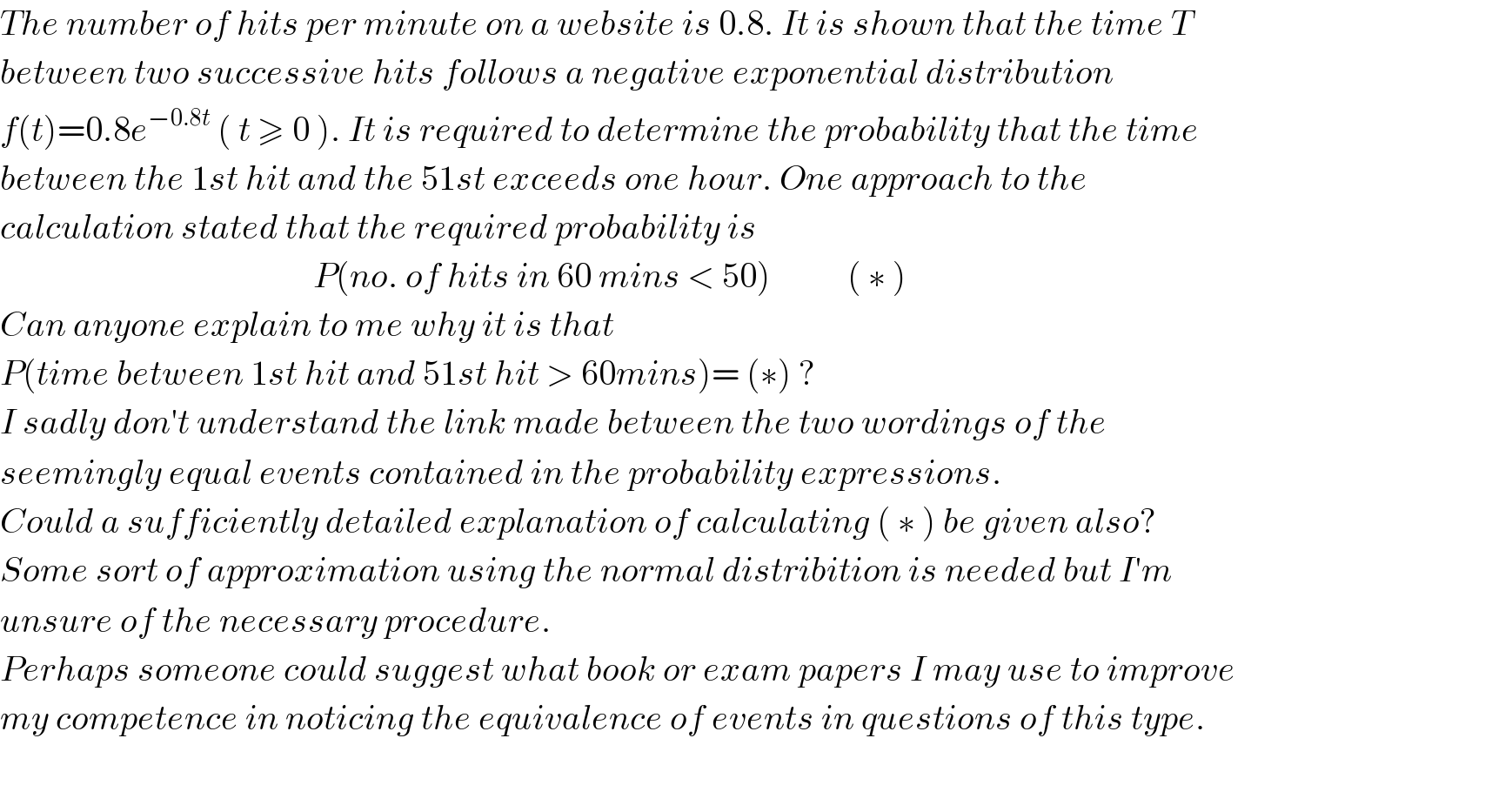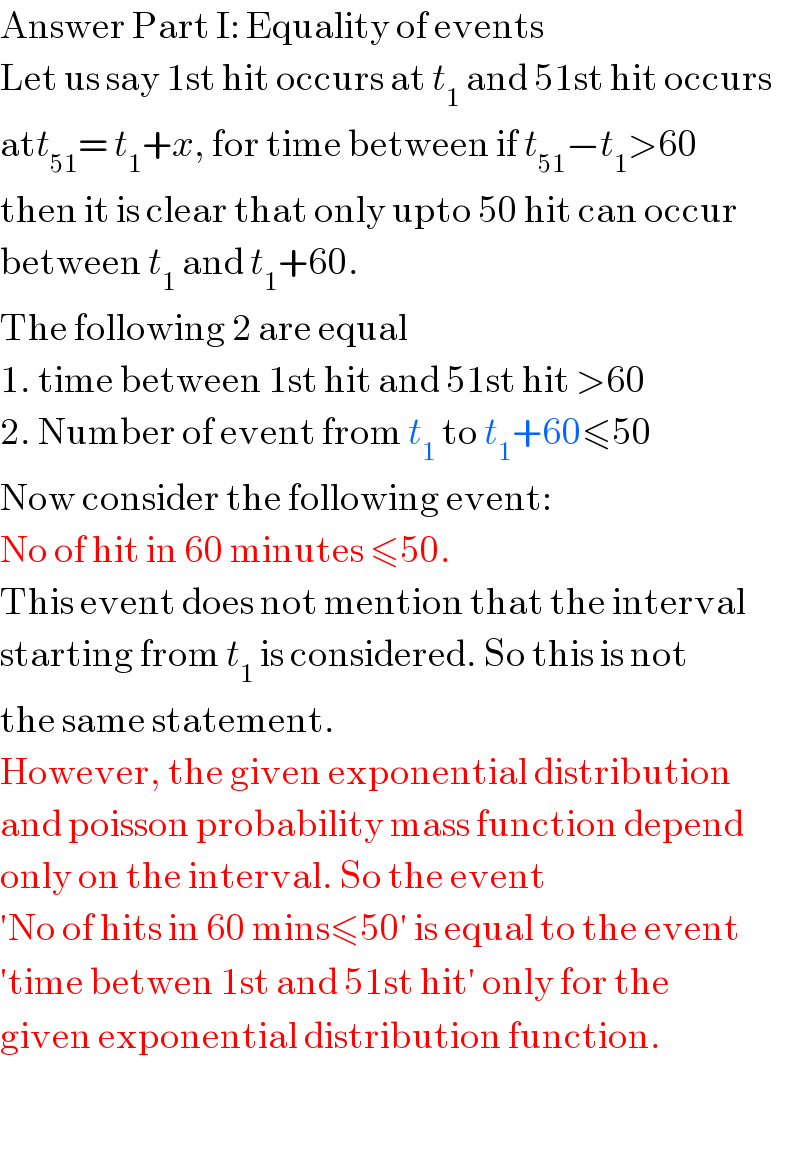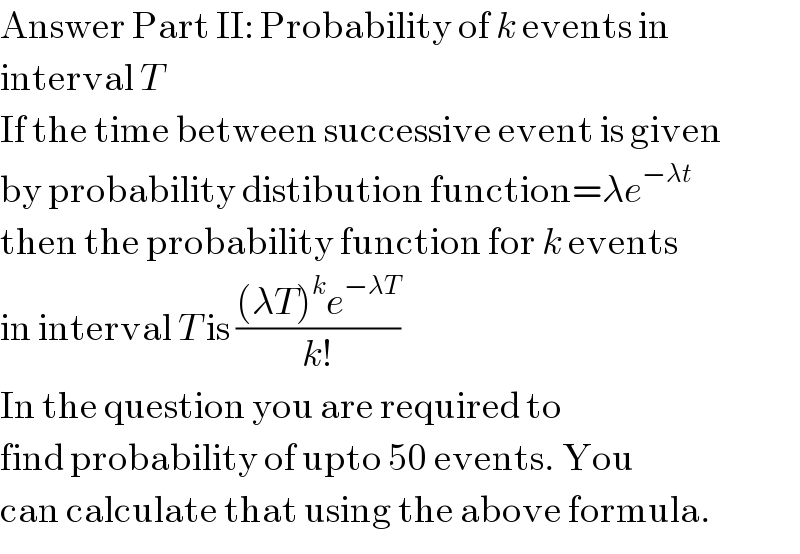
Previous in Probability and Statistics Next in Probability and Statistics
Question Number 973 by Yugi last updated on 10/May/15

$${The}\:{number}\:{of}\:{hits}\:{per}\:{minute}\:{on}\:{a}\:{website}\:{is}\:\mathrm{0}.\mathrm{8}.\:{It}\:{is}\:{shown}\:{that}\:{the}\:{time}\:{T} \\ $$$${between}\:{two}\:{successive}\:{hits}\:{follows}\:{a}\:{negative}\:{exponential}\:{distribution}\: \\ $$$${f}\left({t}\right)=\mathrm{0}.\mathrm{8}{e}^{−\mathrm{0}.\mathrm{8}{t}} \:\left(\:{t}\:\geqslant\:\mathrm{0}\:\right).\:{It}\:{is}\:{required}\:{to}\:{determine}\:{the}\:{probability}\:{that}\:{the}\:{time}\: \\ $$$${between}\:{the}\:\mathrm{1}{st}\:{hit}\:{and}\:{the}\:\mathrm{51}{st}\:{exceeds}\:{one}\:{hour}.\:{One}\:{approach}\:{to}\:{the}\: \\ $$$${calculation}\:{stated}\:{that}\:{the}\:{required}\:{probability}\:{is}\: \\ $$$$\:\:\:\:\:\:\:\:\:\:\:\:\:\:\:\:\:\:\:\:\:\:\:\:\:\:\:\:\:\:\:\:\:\:\:\:\:\:\:\:\:\:\:\:\:{P}\left({no}.\:{of}\:{hits}\:{in}\:\mathrm{60}\:{mins}\:<\:\mathrm{50}\right)\:\:\:\:\:\:\:\:\:\:\:\left(\:\ast\:\right) \\ $$$${Can}\:{anyone}\:{explain}\:{to}\:{me}\:{why}\:{it}\:{is}\:{that} \\ $$$${P}\left({time}\:{between}\:\mathrm{1}{st}\:{hit}\:{and}\:\mathrm{51}{st}\:{hit}\:>\:\mathrm{60}{mins}\right)=\:\left(\ast\right)\:? \\ $$$${I}\:{sadly}\:{don}'{t}\:{understand}\:{the}\:{link}\:{made}\:{between}\:{the}\:{two}\:{wordings}\:{of}\:{the} \\ $$$${seemingly}\:{equal}\:{events}\:{contained}\:{in}\:{the}\:{probability}\:{expressions}.\: \\ $$$${Could}\:{a}\:{sufficiently}\:{detailed}\:{explanation}\:{of}\:{calculating}\:\left(\:\ast\:\right)\:{be}\:{given}\:{also}? \\ $$$${Some}\:{sort}\:{of}\:{approximation}\:{using}\:{the}\:{normal}\:{distribition}\:{is}\:{needed}\:{but}\:{I}'{m} \\ $$$${unsure}\:{of}\:{the}\:{necessary}\:{procedure}. \\ $$$${Perhaps}\:{someone}\:{could}\:{suggest}\:{what}\:{book}\:{or}\:{exam}\:{papers}\:{I}\:{may}\:{use}\:{to}\:{improve} \\ $$$${my}\:{competence}\:{in}\:{noticing}\:{the}\:{equivalence}\:{of}\:{events}\:{in}\:{questions}\:{of}\:{this}\:{type}. \\ $$$$ \\ $$
Answered by prakash jain last updated on 11/May/15

$$\mathrm{Answer}\:\mathrm{Part}\:\mathrm{I}:\:\mathrm{Equality}\:\mathrm{of}\:\mathrm{events} \\ $$$$\mathrm{Let}\:\mathrm{us}\:\mathrm{say}\:\mathrm{1st}\:\mathrm{hit}\:\mathrm{occurs}\:\mathrm{at}\:{t}_{\mathrm{1}} \:\mathrm{and}\:\mathrm{51st}\:\mathrm{hit}\:\mathrm{occurs} \\ $$$$\mathrm{at}{t}_{\mathrm{51}} =\:{t}_{\mathrm{1}} +{x},\:\mathrm{for}\:\mathrm{time}\:\mathrm{between}\:\mathrm{if}\:{t}_{\mathrm{51}} −{t}_{\mathrm{1}} >\mathrm{60} \\ $$$$\mathrm{then}\:\mathrm{it}\:\mathrm{is}\:\mathrm{clear}\:\mathrm{that}\:\mathrm{only}\:\mathrm{upto}\:\mathrm{50}\:\mathrm{hit}\:\mathrm{can}\:\mathrm{occur} \\ $$$$\mathrm{between}\:{t}_{\mathrm{1}} \:\mathrm{and}\:{t}_{\mathrm{1}} +\mathrm{60}. \\ $$$$\mathrm{The}\:\mathrm{following}\:\mathrm{2}\:\mathrm{are}\:\mathrm{equal} \\ $$$$\mathrm{1}.\:\mathrm{time}\:\mathrm{between}\:\mathrm{1st}\:\mathrm{hit}\:\mathrm{and}\:\mathrm{51st}\:\mathrm{hit}\:>\mathrm{60} \\ $$$$\mathrm{2}.\:\mathrm{Number}\:\mathrm{of}\:\mathrm{event}\:\mathrm{from}\:{t}_{\mathrm{1}} \:\mathrm{to}\:{t}_{\mathrm{1}} +\mathrm{60}\leqslant\mathrm{50} \\ $$$$\mathrm{Now}\:\mathrm{consider}\:\mathrm{the}\:\mathrm{following}\:\mathrm{event}: \\ $$$$\mathrm{No}\:\mathrm{of}\:\mathrm{hit}\:\mathrm{in}\:\mathrm{60}\:\mathrm{minutes}\:\leqslant\mathrm{50}. \\ $$$$\mathrm{This}\:\mathrm{event}\:\mathrm{does}\:\mathrm{not}\:\mathrm{mention}\:\mathrm{that}\:\mathrm{the}\:\mathrm{interval} \\ $$$$\mathrm{starting}\:\mathrm{from}\:{t}_{\mathrm{1}} \:\mathrm{is}\:\mathrm{considered}.\:\mathrm{So}\:\mathrm{this}\:\mathrm{is}\:\mathrm{not} \\ $$$$\mathrm{the}\:\mathrm{same}\:\mathrm{statement}. \\ $$$$\mathrm{However},\:\mathrm{the}\:\mathrm{given}\:\mathrm{exponential}\:\mathrm{distribution}\: \\ $$$$\mathrm{and}\:\mathrm{poisson}\:\mathrm{probability}\:\mathrm{mass}\:\mathrm{function}\:\mathrm{depend} \\ $$$$\mathrm{only}\:\mathrm{on}\:\mathrm{the}\:\mathrm{interval}.\:\mathrm{So}\:\mathrm{the}\:\mathrm{event} \\ $$$$'\mathrm{No}\:\mathrm{of}\:\mathrm{hits}\:\mathrm{in}\:\mathrm{60}\:\mathrm{mins}\leqslant\mathrm{50}'\:\mathrm{is}\:\mathrm{equal}\:\mathrm{to}\:\mathrm{the}\:\mathrm{event} \\ $$$$'\mathrm{time}\:\mathrm{betwen}\:\mathrm{1st}\:\mathrm{and}\:\mathrm{51st}\:\mathrm{hit}'\:\mathrm{only}\:\mathrm{for}\:\mathrm{the} \\ $$$$\mathrm{given}\:\mathrm{exponential}\:\mathrm{distribution}\:\mathrm{function}.\: \\ $$$$ \\ $$
Commented by Yugi last updated on 11/May/15

$${I}\:{see}\:{now}.\:{Thanks}\:{for}\:{the}\:{explanation}\:! \\ $$
Answered by prakash jain last updated on 11/May/15

$$\mathrm{Answer}\:\mathrm{Part}\:\mathrm{II}:\:\mathrm{Probability}\:\mathrm{of}\:{k}\:\mathrm{events}\:\mathrm{in} \\ $$$$\mathrm{interval}\:{T} \\ $$$$\mathrm{If}\:\mathrm{the}\:\mathrm{time}\:\mathrm{between}\:\mathrm{successive}\:\mathrm{event}\:\mathrm{is}\:\mathrm{given} \\ $$$$\mathrm{by}\:\mathrm{probability}\:\mathrm{distibution}\:\mathrm{function}=\lambda{e}^{−\lambda{t}} \\ $$$$\mathrm{then}\:\mathrm{the}\:\mathrm{probability}\:\mathrm{function}\:\mathrm{for}\:{k}\:\mathrm{events} \\ $$$$\mathrm{in}\:\mathrm{interval}\:{T}\:\mathrm{is}\:\frac{\left(\lambda{T}\right)^{{k}} {e}^{−\lambda{T}} }{{k}!} \\ $$$$\mathrm{In}\:\mathrm{the}\:\mathrm{question}\:\mathrm{you}\:\mathrm{are}\:\mathrm{required}\:\mathrm{to} \\ $$$$\mathrm{find}\:\mathrm{probability}\:\mathrm{of}\:\mathrm{upto}\:\mathrm{50}\:\mathrm{events}.\:\mathrm{You} \\ $$$$\mathrm{can}\:\mathrm{calculate}\:\mathrm{that}\:\mathrm{using}\:\mathrm{the}\:\mathrm{above}\:\mathrm{formula}. \\ $$
